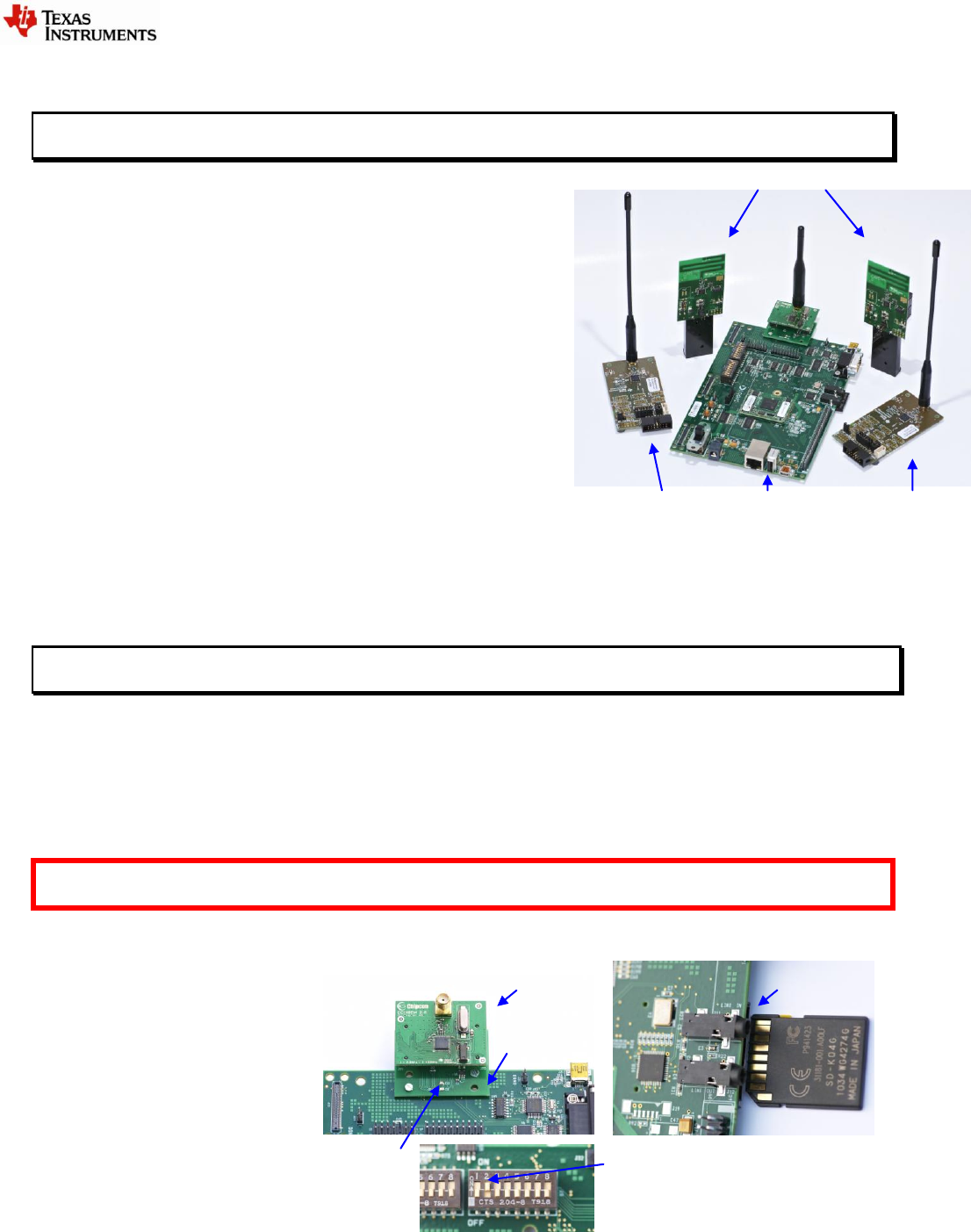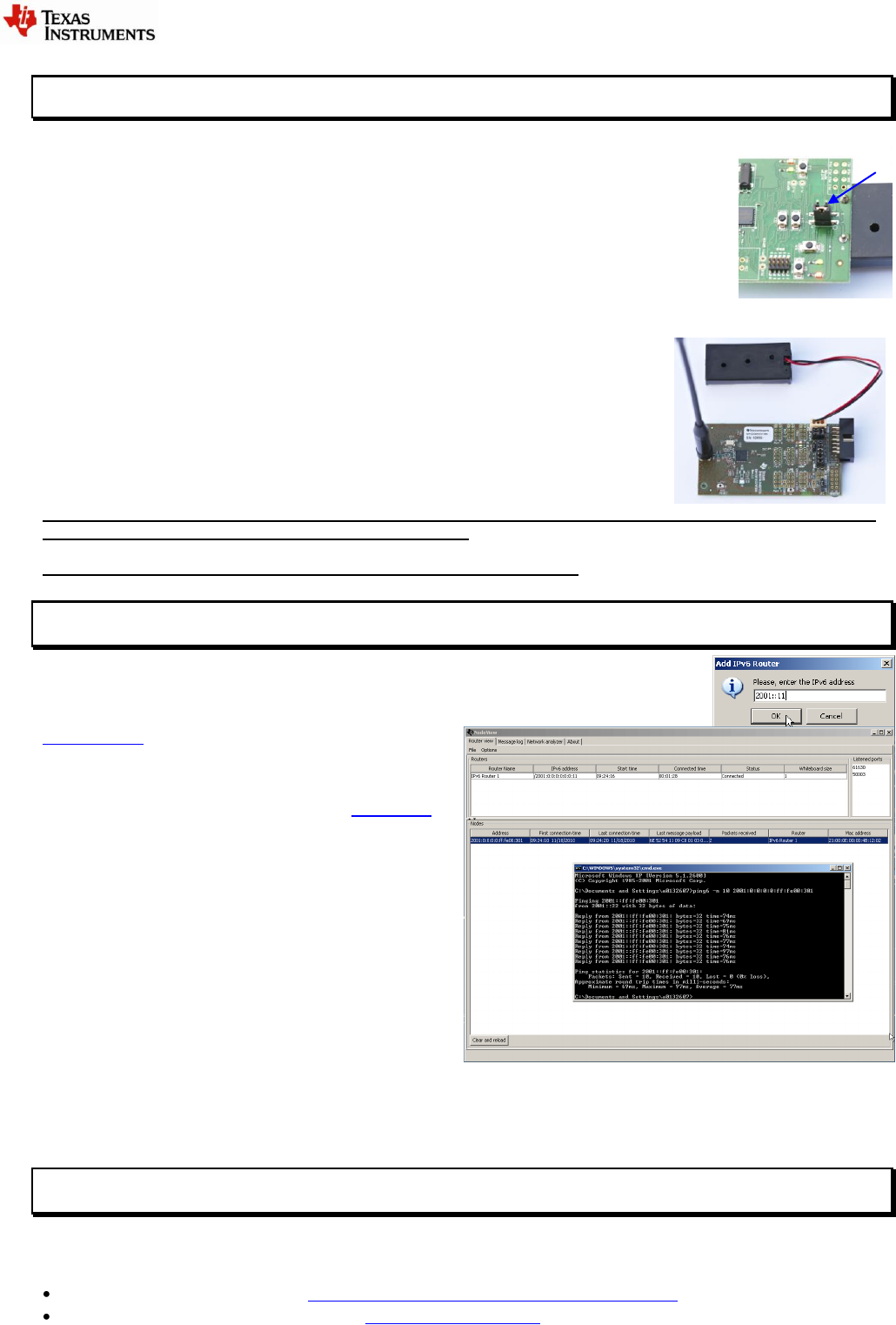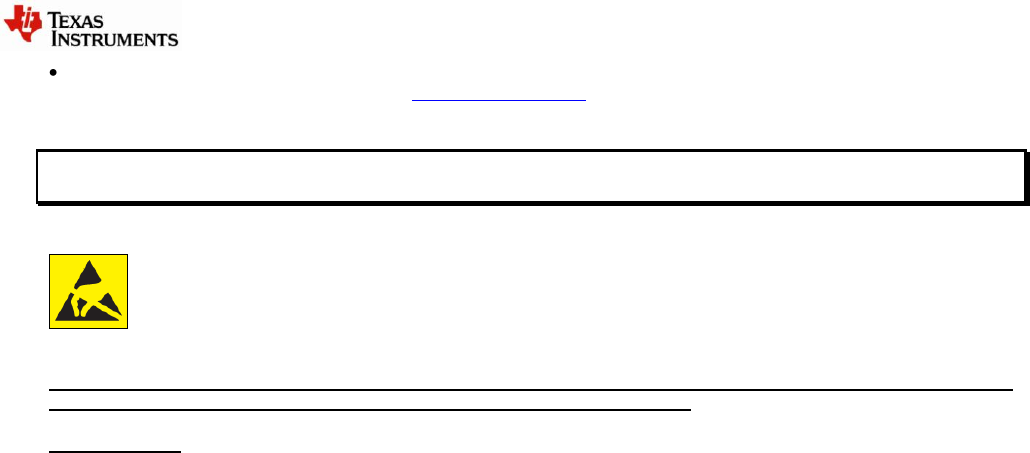Texas Instruments 1180DB868 The CC1180DB is a development tool for TIs sub 1 GHz CC1180 chip. User Manual CC2530ZNP mini kit quick start guide
Texas Instruments Inc. The CC1180DB is a development tool for TIs sub 1 GHz CC1180 chip. CC2530ZNP mini kit quick start guide
Users Manual

SWRU276a
October 2012
1/3
CC1180DB Nodes
CC430 Node
Edge Router
(Gateway)
CC430 Node
CC1180EM
Adapter Card
Green LED
Switch S7-2
SD Card slot
CC-6LOWPAN-DK-868 Quick Start Guide
STEP 1 – Introduction
This guide describes how to set up a CC-6LOWPAN-DK-868 development kit using
the pre-programmed devices of the CC-6LOWPAN-DK-868 Kit.
The 6LoWPAN development kit is designed to give a simple
introduction to 6LoWPAN wireless networks in the 868/915MHz bands. The
hardware consists of an OMAP-L138 based Edge Router equipped with
a CC1180EM, 2 CC430F5137 based nodes and 2 CC1180DB nodes.
The CC1180DB boards consist of a network processor (CC1180)
pre-programmed with a 6LoWPAN software stack, and a MSP430F5438A
microcontroller that controls the 6LoWPAN device.
The CC430 based nodes consists of a CC430F5137 SoC (RF+MCU) that
runs both the 6LoWPAN software stack and the controlling application.
The Edge Router board is running Linux and is pre-programmed with
Sensinode Nanorouter 2.0 software, which acts as a bridge between IPv6
and 6LoWPAN. The Edge Router is connected to a PC via Ethernet. The
Edge Router sets up the network and configures the 6LoWPAN network
parameters.
The development kit demonstrates an example of a typical sensor network with a simple Network Analyzer software
running on the nodes. The nodes are automatically given a unique IPv6 address and can be pinged from a PC using
standard tools. Each node in the 6LoWPAN network also has a unique preprogrammed IEEE address.
The battery powered nodes can act as routers that on request report their key data to the Edge Router.
STEP 2 – Install the PC software and connect the Edge Router
Install the Windows IPv6 stack on a Windows XP PC. The IPv6 installation is not needed in Linux and Windows 7, since
IPv6 is already installed.
Open a command prompt and write ipv6 install
Assign the IPv6 address 2001::22 to the PC using the command prompt: (Run in administrator mode in Windows 7)
netsh interface ipv6 add address “Local Area Connection” 2001::22
Set up a default route using the command prompt: (Run in administrator mode in Windows 7)
netsh interface ipv6 add route ::/0 “Local Area Connection”
Note! You must change “Local Area Connection” to the actual name of the Ethernet connection you want to use. You can
get it from Windows Network Connections. The IPv6 address 2001::22 has to be unique on your network.
Plug in the power cable to the Edge Router and connect the Ethernet cable between the Edge Router and the PC. Make
sure that the Edge Router is not powered on.
Insert the SD card into the slot on the Edge Router.
Connect the CC1180EM to the
adapter card and connect an antenna
to the CC1180EM.
Connect the adapter card to the J30
connector on the Edge Router. The
adapter card can be fastened to the
Edge Router by the provided M2
screws.
Make sure that the switch S7-2 is in position ON,
and all other in position OFF.
Power on the Edge Router using the S4 switch.
It will take approximately 40 seconds to boot the Edge Router. When the green LED on the Adapter Card goes ON it
indicates that the Edge Router is up and running. You can connect the provided RS-232 NULL modem cable between
the Edge Router and PC to get debug information, use e.g. Windows HyperTerminal with settings; Baud Rate 115200, 8
Data Bits, No Parity, One Stop Bit and No Flow Control.

SWRU276a
October 2012
2/3
Jumper J1
STEP 3 – Connecting the nodes to the 6LoWPAN network
Insert batteries in one or more of the CC1180DB boards and make sure the jumper is connected
between P1-1 and P1-2 to power on the node. It will automatically connect to existing network.
LEDs D1 and D2 are controlled from the CC1180 network processor and gives status on node
connection. When the CC1180DB node is connected to the network the green LED (D2) will be on,
if not connected it will be off. The red LED (D1) blink when node is communicating. LEDs D3 and
D4 are controlled from the host MCU and displays the RSSI value. Both LEDs off: RSSI above -
40dBm, green LED on red LED off: RSSI between -40 and -65dBm, both LEDs on: RSSI between
-65 and -90dBm, green LED off red LED on: RSSI below -90dBm. The red LED toggles with 1 sec
interval if 3 concurrent reply messages were missed or Analyzer is not activated on PC.
Insert batteries in one or more of the CC430F5137 battery packs and connect an antenna. Connect the battery pack
cable to power on the node.
LEDs D1 and D2 are controlled from the 6LoWPAN stack in CC430 and gives status on
node connection. When the CC430 node is connected to the network the green LED
(D1) will be on. The red LED (D2) blink when node is communicating.
When nodes are powered on they connect automatically to the 6LoWPAN network,
either directly to the Edge Router or via other nodes (Routers) in the network. Upon
request from the Edge Router they send messages including network information to the
Edge Router.
Warning! To minimize risk of personal injury or property damage, never use rechargeable batteries to power the
boards. Do not leave the EVM powered when unattended.
Note that there should only be one active power source at any one time.
STEP 4 – Installing and Using NodeView Network Analyzer software
Node View can be used to interact with the nodes in the network. It has several powerful
features such as Network Analyzer, message logs, running demo applications and to send
custom data to nodes.
Download and install the latest Java runtime engine from
www.java.com to your Windows PC.
Minimum version of Java to run NodeView is 1.6.0
Extract the provided NodeView package to C:\NodeView
NodeView package can be found via link on www.ti.com
Start NodeView by double-clicking the extracted
NodeViewProDyn.jar file in C:\NodeView
Connect to your Edge Router by selecting File -> Add
NanoRouter IPv6 in the RouterView tab.
Enter the IPv6 address of the Edge Router which is
2001::11
The connected Edge Router is then shown in the Routers
field.
The connected nodes are shown in the Nodes field. You
can now use standard network tools to communicate with
the nodes. To ping a node right-click a node and copy the IPv6 address of the node. Open a command prompt on your
Windows XP PC and write: ping6 –n 10 [IPv6 address] Replace [IPv6 address] with the copied IPv6 address of
the node you want to ping. This example will ping the node 10 times. Use the ping command on Linux and Windows 7.
You can also view the network topology in the NodeView tab Network analyzer.
STEP 5 – Next steps
Extensive examples are provided to help you get started. Building and running each example is recommended to
become acquainted with the devices. Refer to the examples’ wiki page for more information.
For detailed information about the sample applications please see the following resources:
CC-6LOWPAN-DK-868 wiki page: http://processors.wiki.ti.com/index.php/CC-6LoWPAN
CC-6LOWPAN-DK-868 product web page: http://www.ti.com/6lowpan

SWRU276a
October 2012
3/3
The Low Power RF Online Community has forums, blogs and videos. Use the forums to find information, discuss
and get help with your design. Join us at www.ti.com/lprf-forum
STEP 6 – More Information
The hardware in this kit is FCC/IC certified and complies with ETSI/R&TTE over temperature from 0 to +35°C. The
W5017 whip antenna (used on the Gateway) from Pulse has a gain of 2 dBi.
Important note: The CC-6LOWPAN-DK-868 kit is an educational tool that allows developers to get familiar with basic
6LoWPAN networks. It is not intended as a 6LoWPAN reference design.
Caution! The kit contains ESD
sensitive components. Handle with
care to prevent permanent damage.
To minimize risk of injury, avoid
touching components during
operation if symbolized as hot.

EVALUATION BOARD/KIT/MODULE (EVM) ADDITIONAL TERMS
Texas Instruments (TI) provides the enclosed Evaluation Board/Kit/Module (EVM) under the following conditions:
The user assumes all responsibility and liability for proper and safe handling of the goods. Further, the user indemnifies TI from all claims
arising from the handling or use of the goods.
Should this evaluation board/kit not meet the specifications indicated in the User’s Guide, the board/kit may be returned within 30 days from
the date of delivery for a full refund. THE FOREGOING LIMITED WARRANTY IS THE EXCLUSIVE WARRANTY MADE BY SELLER TO
BUYER AND IS IN LIEU OF ALL OTHER WARRANTIES, EXPRESSED, IMPLIED, OR STATUTORY, INCLUDING ANY WARRANTY OF
MERCHANTABILITY OR FITNESS FOR ANY PARTICULAR PURPOSE. EXCEPT TO THE EXTENT OF THE INDEMNITY SET FORTH
ABOVE, NEITHER PARTY SHALL BE LIABLE TO THE OTHER FOR ANY INDIRECT, SPECIAL, INCIDENTAL, OR CONSEQUENTIAL
DAMAGES.
Please read the User's Guide and, specifically, the Warnings and Restrictions notice in the User's Guide prior to handling the product. This
notice contains important safety information about temperatures and voltages. For additional information on TI's environmental and/or safety
programs, please visit www.ti.com/esh or contact TI.
No license is granted under any patent right or other intellectual property right of TI covering or relating to any machine, process, or
combination in which such TI products or services might be or are used. TI currently deals with a variety of customers for products, and
therefore our arrangement with the user is not exclusive. TI assumes no liability for applications assistance, customer product design,
software performance, or infringement of patents or services described herein.
REGULATORY COMPLIANCE INFORMATION
As noted in the EVM User’s Guide and/or EVM itself, this EVM and/or accompanying hardware may or may not be subject to the Federal
Communications Commission (FCC) and Industry Canada (IC) rules.
For EVMs not subject to the above rules, this evaluation board/kit/module is intended for use for ENGINEERING DEVELOPMENT,
DEMONSTRATION OR EVALUATION PURPOSES ONLY and is not considered by TI to be a finished end product fit for general consumer
use. It generates, uses, and can radiate radio frequency energy and has not been tested for compliance with the limits of computing
devices pursuant to part 15 of FCC or ICES-003 rules, which are designed to provide reasonable protection against radio frequency
interference. Operation of the equipment may cause interference with radio communications, in which case the user at his own expense will
be required to take whatever measures may be required to correct this interference.
General Statement for EVMs including a radio
User Power/Frequency Use Obligations: This radio is intended for development/professional use only in legally allocated frequency and
power limits. Any use of radio frequencies and/or power availability of this EVM and its development application(s) must comply with local
laws governing radio spectrum allocation and power limits for this evaluation module. It is the user’s sole responsibility to only operate this
radio in legally acceptable frequency space and within legally mandated power limitations. Any exceptions to this are strictly prohibited and
unauthorized by Texas Instruments unless user has obtained appropriate experimental/development licenses from local regulatory
authorities, which is responsibility of user including its acceptable authorization.
For EVMs annotated as FCC – FEDERAL COMMUNICATIONS COMMISSION Part 15 Compliant
Caution
This device complies with part 15 of the FCC Rules. Operation is subject to the following two conditions: (1) This device may not cause
harmful interference, and (2) this device must accept any interference received, including interference that may cause undesired operation.
Changes or modifications not expressly approved by the party responsible for compliance could void the user's authority to operate the
equipment.
FCC Interference Statement for Class A EVM devices
This equipment has been tested and found to comply with the limits for a Class A digital device, pursuant to part 15 of the FCC Rules.
These limits are designed to provide reasonable protection against harmful interference when the equipment is operated in a commercial
environment. This equipment generates, uses, and can radiate radio frequency energy and, if not installed and used in accordance with the
instruction manual, may cause harmful interference to radio communications. Operation of this equipment in a residential area is likely to
cause harmful interference in which case the user will be required to correct the interference at his own expense.
FCC Interference Statement for Class B EVM devices
This equipment has been tested and found to comply with the limits for a Class B digital device, pursuant to part 15 of the FCC Rules.
These limits are designed to provide reasonable protection against harmful interference in a residential installation. This equipment
generates, uses and can radiate radio frequency energy and, if not installed and used in accordance with the instructions, may cause
harmful interference to radio communications. However, there is no guarantee that interference will not occur in a particular installation. If
this equipment does cause harmful interference to radio or television reception, which can be determined by turning the equipment off and
on, the user is encouraged to try to correct the interference by one or more of the following measures:
• Reorient or relocate the receiving antenna.
• Increase the separation between the equipment and receiver.
• Connect the equipment into an outlet on a circuit different from that to which the receiver is connected.
• Consult the dealer or an experienced radio/TV technician for help.
For EVMs annotated as IC – INDUSTRY CANADA Compliant
This Class A or B digital apparatus complies with Canadian ICES-003.
Changes or modifications not expressly approved by the party responsible for compliance could void the user’s authority to operate the
equipment.
Concerning EVMs including radio transmitters
This device complies with Industry Canada licence-exempt RSS standard(s). Operation is subject to the following two conditions: (1) this
device may not cause interference, and (2) this device must accept any interference, including interference that may cause undesired
operation of the device.
Concerning EVMs including detachable antennas
Under Industry Canada regulations, this radio transmitter may only operate using an antenna of a type and maximum (or lesser) gain
approved for the transmitter by Industry Canada. To reduce potential radio interference to other users, the antenna type and its gain should
be so chosen that the equivalent isotropically radiated power (e.i.r.p.) is not more than that necessary for successful communication.
This radio transmitter has been approved by Industry Canada to operate with the antenna types listed in the user guide with the maximum
permissible gain and required antenna impedance for each antenna type indicated. Antenna types not included in this list, having a gain
greater than the maximum gain indicated for that type, are strictly prohibited for use with this device.
Cet appareil numérique de la classe A ou B est conforme à la norme NMB-003 du Canada.
Les changements ou les modifications pas expressément approuvés par la partie responsable de la conformité ont pu vider l’autorité de
l'utilisateur pour actionner l'équipement.
Concernant les EVMs avec appareils radio
Le présent appareil est conforme aux CNR d'Industrie Canada applicables aux appareils radio exempts de licence. L'exploitation est
autorisée aux deux conditions suivantes : (1) l'appareil ne doit pas produire de brouillage, et (2) l'utilisateur de l'appareil doit accepter tout
brouillage radioélectrique subi, même si le brouillage est susceptible d'en compromettre le fonctionnement.
Concernant les EVMs avec antennes détachables
Conformément à la réglementation d'Industrie Canada, le présent émetteur radio peut fonctionner avec une antenne d'un type et d'un gain
maximal (ou inférieur) approuvé pour l'émetteur par Industrie Canada. Dans le but de réduire les risques de brouillage radioélectrique à
l'intention des autres utilisateurs, il faut choisir le type d'antenne et son gain de sorte que la puissance isotrope rayonnée équivalente
(p.i.r.e.) ne dépasse pas l'intensité nécessaire à l'établissement d'une communication satisfaisante.
Le présent émetteur radio a été approuvé par Industrie Canada pour fonctionner avec les types d'antenne énumérés dans le manuel
d’usage et ayant un gain admissible maximal et l'impédance requise pour chaque type d'antenne. Les types d'antenne non inclus dans
cette liste, ou dont le gain est supérieur au gain maximal indiqué, sont strictement interdits pour l'exploitation de l'émetteur.
SPACER
SPACER
SPACER
SPACER
SPACER
SPACER
SPACER
SPACER

【【Important Notice for Users of this Product in Japan】】
This development kit is NOT certified as Confirming to Technical Regulations of Radio Law of Japan
If you use this product in Japan, you are required by Radio Law of Japan to follow the instructions below with respect to this product:
1. Use this product in a shielded room or any other test facility as defined in the notification #173 issued by Ministry of Internal Affairs and
Communications on March 28, 2006, based on Sub-section 1.1 of Article 6 of the Ministry’s Rule for Enforcement of Radio Law of
Japan,
2. Use this product only after you obtained the license of Test Radio Station as provided in Radio Law of Japan with respect to this
product, or
3. Use of this product only after you obtained the Technical Regulations Conformity Certification as provided in Radio Law of Japan with
respect to this product. Also, please do not transfer this product, unless you give the same notice above to the transferee. Please note
that if you could not follow the instructions above, you will be subject to penalties of Radio Law of Japan.
Texas Instruments Japan Limited
(address) 24-1, Nishi-Shinjuku 6 chome, Shinjuku-ku, Tokyo, Japan
http://www.tij.co.jp
【ご使用にあたっての注】
本開発キットは技術基準適合証明を受けておりません。
本製品のご使用に際しては、電波法遵守のため、以下のいずれかの措置を取っていただく必要がありますのでご注意ください。
1. 電波法施行規則第6条第1項第1号に基づく平成18年3月28日総務省告示第173号で定められた電波暗室等の試験設備でご使用いただく。
2. 実験局の免許を取得後ご使用いただく。
3. 技術基準適合証明を取得後ご使用いただく。
なお、本製品は、上記の「ご使用にあたっての注意」を譲渡先、移転先に通知しない限り、譲渡、移転できないものとします。
上記を遵守頂けない場合は、電波法の罰則が適用される可能性があることをご留意ください。
日本テキサス・インスツルメンツ株式会社
東京都新宿区西新宿6丁目24番1号
西新宿三井ビル
http://www.tij.co.jp
SPACER
SPACER
SPACER
SPACER
SPACER
SPACER
SPACER
SPACER
SPACER
SPACER
SPACER
SPACER
SPACER
SPACER
SPACER
SPACER
EVALUATION BOARD/KIT/MODULE (EVM)
WARNINGS, RESTRICTIONS AND DISCLAIMERS
For Feasibility Evaluation Only, in Laboratory/Development Environments. Unless otherwise indicated, this EVM is not a finished
electrical equipment and not intended for consumer use. It is intended solely for use for preliminary feasibility evaluation in
laboratory/development environments by technically qualified electronics experts who are familiar with the dangers and application risks
associated with handling electrical mechanical components, systems and subsystems. It should not be used as all or part of a finished end
product.
Your Sole Responsibility and Risk. You acknowledge, represent and agree that:
1. You have unique knowledge concerning Federal, State and local regulatory requirements (including but not limited to Food and Drug
Administration regulations, if applicable) which relate to your products and which relate to your use (and/or that of your employees,
affiliates, contractors or designees) of the EVM for evaluation, testing and other purposes.
2. You have full and exclusive responsibility to assure the safety and compliance of your products with all such laws and other applicable
regulatory requirements, and also to assure the safety of any activities to be conducted by you and/or your employees, affiliates,
contractors or designees, using the EVM. Further, you are responsible to assure that any interfaces (electronic and/or mechanical)
between the EVM and any human body are designed with suitable isolation and means to safely limit accessible leakage currents to
minimize the risk of electrical shock hazard.
3. You will employ reasonable safeguards to ensure that your use of the EVM will not result in any property damage, injury or death, even
if the EVM should fail to perform as described or expected.
4. You will take care of proper disposal and recycling of the EVM’s electronic components and packing materials.
Certain Instructions. It is important to operate this EVM within TI’s recommended specifications and environmental considerations per the
user guidelines. Exceeding the specified EVM ratings (including but not limited to input and output voltage, current, power, and
environmental ranges) may cause property damage, personal injury or death. If there are questions concerning these ratings please contact
a TI field representative prior to connecting interface electronics including input power and intended loads. Any loads applied outside of the
specified output range may result in unintended and/or inaccurate operation and/or possible permanent damage to the EVM and/or
interface electronics. Please consult the EVM User's Guide prior to connecting any load to the EVM output. If there is uncertainty as to the
load specification, please contact a TI field representative. During normal operation, some circuit components may have case temperatures
greater than 60°C as long as the input and output are maintained at a normal ambient operating temperature. These components include
but are not limited to linear regulators, switching transistors, pass transistors, and current sense resistors which can be identified using the
EVM schematic located in the EVM User's Guide. When placing measurement probes near these devices during normal operation, please
be aware that these devices may be very warm to the touch. As with all electronic evaluation tools, only qualified personnel knowledgeable
in electronic measurement and diagnostics normally found in development environments should use these EVMs.
Agreement to Defend, Indemnify and Hold Harmless. You agree to defend, indemnify and hold TI, its licensors and their representatives
harmless from and against any and all claims, damages, losses, expenses, costs and liabilities (collectively, "Claims") arising out of or in
connection with any use of the EVM that is not in accordance with the terms of the agreement. This obligation shall apply whether Claims
arise under law of tort or contract or any other legal theory, and even if the EVM fails to perform as described or expected.
Safety-Critical or Life-Critical Applications. If you intend to evaluate the components for possible use in safety critical applications (such
as life support) where a failure of the TI product would reasonably be expected to cause severe personal injury or death, such as devices
which are classified as FDA Class III or similar classification, then you must specifically notify TI of such intent and enter into a separate
Assurance and Indemnity Agreement.
Mailing Address: Texas Instruments, Post Office Box 655303, Dallas, Texas 75265
Copyright © 2012, Texas Instruments Incorporated